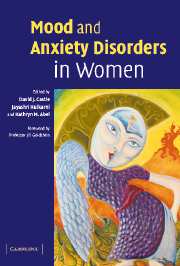Book contents
- Frontmatter
- Contents
- Contributors
- Preface
- Foreword
- 1 Pubertal development and the emergence of the gender gap in mood disorders: A developmental and evolutionary synthesis
- 2 Borderline personality disorder: Sex differences
- 3 Substance use and abuse in women
- 4 Anxiety disorders in women
- 5 Posttraumatic stress disorder in women
- 6 Domestic violence and its impact on mood disorder in women: Implications for mental health workers
- 7 Depression in women: Hormonal influences
- 8 Anxiety and mood disorders in pregnancy and the postpartum period
- 9 Pharmacological treatment of anxiety and depression in pregnancy and lactation
- 10 Bipolar affective disorder: Special issues for women
- 11 Mood and menopause
- 12 Anxiety and depression in women in old age
- Index
2 - Borderline personality disorder: Sex differences
Published online by Cambridge University Press: 13 August 2009
- Frontmatter
- Contents
- Contributors
- Preface
- Foreword
- 1 Pubertal development and the emergence of the gender gap in mood disorders: A developmental and evolutionary synthesis
- 2 Borderline personality disorder: Sex differences
- 3 Substance use and abuse in women
- 4 Anxiety disorders in women
- 5 Posttraumatic stress disorder in women
- 6 Domestic violence and its impact on mood disorder in women: Implications for mental health workers
- 7 Depression in women: Hormonal influences
- 8 Anxiety and mood disorders in pregnancy and the postpartum period
- 9 Pharmacological treatment of anxiety and depression in pregnancy and lactation
- 10 Bipolar affective disorder: Special issues for women
- 11 Mood and menopause
- 12 Anxiety and depression in women in old age
- Index
Summary
Borderline personality disorder (BPD) is a severe mental disorder, characterised in the Diagnostic and Statistical Manual of Mental Disorders (DSM-IV-TR (APA, 2000)) by a pervasive pattern of instability of interpersonal relationships, self-image and affects and marked impulsivity. It is the most common and the most serious of the personality disorders (PDs) in clinical practice (Work Group on Borderline Personality Disorder, 2001). BPD is associated with considerable distress, psychosocial impairment, morbidity and mortality (Work Group on Borderline Personality Disorder, 2001) and is of particular relevance to this volume because, according to DSM-IV-TR, it is one of three PDs (along with histrionic and dependent PDs) diagnosed more frequently in women. This chapter provides an overview of sex differences in BPD, covering clinical presentation, longitudinal course, aetiological factors and neurobiological underpinnings.
Diagnostic features
The DSM-IV describes nine diagnostic criteria for BPD, with a cut-point of five to achieve “caseness”. These criteria include
frantic efforts to avoid real or imagined abandonment,
a pattern of unstable and intense interpersonal relationships,
identity disturbance,
impulsivity,
recurrent deliberate self-harm,
affective instability,
chronic feelings of emptiness,
inappropriate, intense anger and
transient, stress-related paranoid ideation or severe dissociative symptoms.
This categorical approach to the diagnosis of PDs has been the subject of trenchant criticism. Diagnoses, including BPD have been described as “convenient fictions that inadequately describe complex psychopathology and have very limited relevance to treatment planning” (Ball, 2001, p. 148) and empirical studies have failed to support such categories (Livesley, 2001).
Keywords
- Type
- Chapter
- Information
- Mood and Anxiety Disorders in Women , pp. 20 - 38Publisher: Cambridge University PressPrint publication year: 2006

